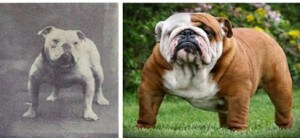
The English bulldog is one of the most popular breeds and it’s also a national icon, symbolising British pluck. But many experts have long cited this breed as symbolising all that is wrong with dog-fancy, due to their sheer number of health problems. In 2004, a survey by the Kennel Club of Great Britain found that the breed die at the median age of 6.25 years. Now, a new genetic study has added weight to the debate of breeding for health rather than appearance.
Published in the journal Canine Genetics and Epidemiology, the study suggests that due to selective breeding, the Bulldog has become so inbred it cannot be returned to health without an infusion of new bloodlines.
Researchers from the University of California, Davis, tested the DNA of 102 registered English Bulldogs. The team found Bulldogs had very low levels of diversity (a measure of relatedness among individual dogs) to breed out the harmful traits we find desirable in the Bulldog, like a short nose, layered skin and a stocky build, have further reduced variety in that breed’s gene pool.
Dr Niels Pedersen, a professor at UC Davis School of Veterinary Medicine’s Center for Companion Animal Health, who led the study says: “There are a whole litany of different problems associated with their structure and inbreeding. We were not surprised to find they did lack genetic diversity.” He went onto say: “The English Bulldog truly is a breed in trouble. Inbreeding…has brought the breed to a crisis point.”
Over the centuries, the English Bulldog has been bred in such a way that the researchers believe there is now very little ‘wiggle room’ for making additional genetic changes that might help reduce the health issues that English Bulldogs often face. These include; breathing issues due to their shortened snout, skins complaints because of their layered skin, and joint disease such as hip and elbow dysplasia, or ruptures in the spine due to their conformation.
 The English Bulldog can trace its genetic origins to a founder population of just 68 dogs after 1835. Thanks to human interference, the Bulldog has dramatically changed in appearance – as we can see from the image published in the 1915 book ‘Breeds of All Nations’ by W.E. Mason, versus the image of the English Bulldog we know today.
The English Bulldog can trace its genetic origins to a founder population of just 68 dogs after 1835. Thanks to human interference, the Bulldog has dramatically changed in appearance – as we can see from the image published in the 1915 book ‘Breeds of All Nations’ by W.E. Mason, versus the image of the English Bulldog we know today.
While this genetic study has predicted a grim future for the continuation of the breed, there has been some attempt to expand the gene pool through breeding with other types of dogs. This has the ultimate goal of achieving improved health. However, there’s still a long way to go in convincing many breeders across the globe that it’s time for change, looks aren’t everything and health should always come first.
Learn more about our classes

Get Hanne's book, clothing and more
Hanne has a number of publications including her book Playing With Your Dog to help owners work out the games that are best suited for their pet to play throughout his life, from puppyhood to old age, available from Amazon. Check out Hanne's range of contemporary casuals The Collection – for pet lovers made from recyclable, organic materials that are sustainably sourced.

